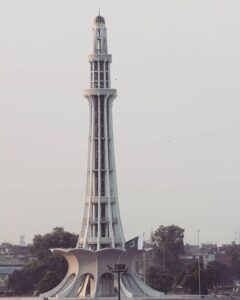Introduction
Minar-e-Pakistan, located in the heart of Lahore, stands not just as a towering structure but as a symbol of Pakistan’s creation and the resilience of its people. This historical monument reminds visitors of the 1940 Lahore Resolution, when leaders formally demanded a separate nation for Muslims of the Indian subcontinent. Today, people from all over the country and abroad recognize it as one of Pakistan’s most iconic landmarks and visit it with admiration.
Location and Historical of Minar-e-Pakistan
Location:
Located in Iqbal Park, Lahore—one of the largest urban parks in the country—Minar-e-Pakistan stands near the Badshahi Mosque and the Lahore Fort, making it a central attraction in the city’s rich historical landscape
Historical Background
The All-India Muslim League passed the Lahore Resolution on March 23, 1940, at this site, which the monument commemorates. This resolution laid the foundation for the demand for an independent state, eventually leading to the creation of Pakistan in 1947.
Architectural Design
The design of Minar-e-Pakistan blends Islamic, Mughal, and modern architecture, symbolizing Pakistan’s rich cultural heritage and its vision for the future.
Height: The monument stands at an impressive 70 meters (230 feet).
Base: The base of the tower is shaped like a five-pointed star, surrounded by a platform shaped like a blooming flower. The lower portion reflects Mughal architectural style with floral patterns and carved motifs.
Material: The base is constructed using stone and marble, while the upper parts of the minar are made from reinforced concrete, giving it a sleek, modern look.
Symbolism: The platform of the monument symbolizes the stages of Pakistan’s independence movement. Rough stone forms the lower steps, representing the struggle for freedom, while smooth marble shapes the upper steps, symbolizing the achievement of independence.
Interesting Facts of Minar-e-Pakistan
Foundation Year: The construction of the monument started in 1960 and was completed in 1968.
Architect: The monument was designed by Nasreddin Murat-Khan, a Pakistani architect of Russian origin.
Inscriptions: On the base of the Minar, you’ll find inscriptions of key historical texts, including the Lahore Resolution in both Urdu and Bengali, along with excerpts from the Quran and speeches by prominent leaders like Allama Iqbal and Muhammad Ali Jinnah.
Viewing Platform: Visitors can go up to the viewing platform at the top, from where they can enjoy panoramic views of the city, including the Badshahi Mosque, Lahore Fort, and the Ravi River.
Visiting Time
1. Best Time to Visit
Morning: Early mornings are ideal for a peaceful visit and to avoid crowds.
Evening: The monument is beautifully illuminated at night, making it a popular spot for evening strolls.
2. Things to Do
Explore Iqbal Park: The park surrounding is a great spot for picnics, family outings, or relaxing walks. It also features fountains, flower beds, and green lawns.
Nearby Attractions: After visiting, you can explore nearby historical sites such as:
Badshahi Mosque: One of the largest mosques in the world, located just a few minutes away.
Lahore Fort: A UNESCO World Heritage site, showcasing Mughal architecture and history.
Shalimar Gardens: Another Mughal-era garden located nearby, perfect for a leisurely visit.
Cultural Importance
Tips for Visiting
Entry Fee: There is no entry fee to visit the monument, making it accessible to everyone.
Parking: Iqbal Park has designated parking areas, but it’s advisable to visit early on weekends or public holidays to avoid crowds.
Photography: The monument and its surroundings provide excellent photography opportunities, especially during the golden hour at sunset.
Respect the Landmark: Given the historical and cultural significance of this park, visitors are expected to show respect and maintain cleanliness during their visit.